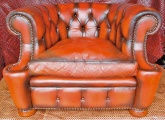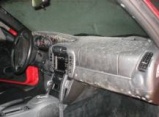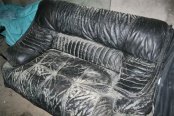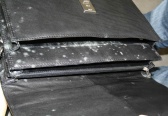Difference between revisions of "Leather smell"
(→The smell of leather) |
|||
| Line 5: | Line 5: | ||
==The smell of leather== | ==The smell of leather== | ||
| − | Everyone knows the soothing scent of old [[leather]], but nowadays there are hardly any leathers that exude this beautiful smell. | + | Everyone knows the soothing scent of old [[leather]], but nowadays there are hardly any leathers that exude this beautiful smell. This is due to the fact that leather was [[Tanning leather|tanned]] differently in the past. [[Vegetable-tanned leather|Vegetable tanning]] was then the main tanning method. The [[Tannins|tanning agents]] and [[Oils & fats in the leather industry|fats and oils]] gave the leather a special odour. Some of the odoriferous substances used in the past are even prohibited today. In particular, some nitro-musk compounds which strongly influenced the smell of leather. |
| Line 20: | Line 20: | ||
</p> | </p> | ||
<p align=center> | <p align=center> | ||
| − | ''Leather odours are always different depending on origin of the leather, | + | ''Leather odours are always different depending on the origin of the leather, the [[Types of leather|type of leather]], the [[leather colour|colour chemicals]], the [[Oils & fats in the leather industry|refatting substances]] and on the preservatives and [[tannins]] used.'' |
</p> | </p> | ||
| − | Today, most | + | Today, most [[Car leather|car]], [[leather furniture|furniture]] and [[leather clothing|clothing leather]] is [[chrome tanned]]. This [[Tanning leather|tanning method]] is less odour intensive. Also there is more than one leather smell. Depending on the [[Oils & fats in the leather industry|refatting substances]], [[leather colour|dyeing and colour chemicals]] and many other substances used, the resulting leather smells differently. Consequently, the mixture of individual odours of the substances gives the final smell of the leather. |
| − | Most [[car leather|automotive manufacturers]] attach great importance to | + | Most [[car leather|automotive manufacturers]] attach great importance to having as little odour as possible, also referred to as new car smell. For testing, the interior of a vehicle is heated to 70 ° C, as odours intensify with rising temperature. Experts with particularly sensitive noses then test the interior for strong and unwanted odours. Most manufacturers prefer an odour-free interior so as to avoid complaints. |
| − | The smell | + | The smell policies of the various manufacturers (2015) are as follows: |
* VW: "Leather seats must smell like leather." | * VW: "Leather seats must smell like leather." | ||
* BMW: "The best smell is no smell." | * BMW: "The best smell is no smell." | ||
| Line 38: | Line 38: | ||
| − | Since many consumers | + | Since many consumers believe that a leather smell is pleasant, it has long been investigated how to control the smell during the [[Leather production|production of leather]]. However, since the leather smell is produced by a mixture of the [[tannins]], [[Oils & fats in the leather industry|refatting agents]], [[leather colour|dyestuffs]], binders and preservatives used in the production process, the final leather odour cannot be controlled. Most chemical components are necessary to achieve the desired [[leather quality]]. If an element is exchanged for a certain smell, the quality parameters of the leather are often changed too. |
| − | + | ||
==Micro hollow balls== | ==Micro hollow balls== | ||
Revision as of 13:53, 3 April 2017
Contents
The smell of leather
Everyone knows the soothing scent of old leather, but nowadays there are hardly any leathers that exude this beautiful smell. This is due to the fact that leather was tanned differently in the past. Vegetable tanning was then the main tanning method. The tanning agents and fats and oils gave the leather a special odour. Some of the odoriferous substances used in the past are even prohibited today. In particular, some nitro-musk compounds which strongly influenced the smell of leather.
Leather odours are always different depending on the origin of the leather, the type of leather, the colour chemicals, the refatting substances and on the preservatives and tannins used.
Today, most car, furniture and clothing leather is chrome tanned. This tanning method is less odour intensive. Also there is more than one leather smell. Depending on the refatting substances, dyeing and colour chemicals and many other substances used, the resulting leather smells differently. Consequently, the mixture of individual odours of the substances gives the final smell of the leather.
Most automotive manufacturers attach great importance to having as little odour as possible, also referred to as new car smell. For testing, the interior of a vehicle is heated to 70 ° C, as odours intensify with rising temperature. Experts with particularly sensitive noses then test the interior for strong and unwanted odours. Most manufacturers prefer an odour-free interior so as to avoid complaints.
The smell policies of the various manufacturers (2015) are as follows:
- VW: "Leather seats must smell like leather."
- BMW: "The best smell is no smell."
- Mercedes Benz: "Leather is the only permissible smell."
- Volvo: "Minimize all odours."
- Audi: "Neutral smell."
- Ford: "Target: Eliminate all odours."
Since many consumers believe that a leather smell is pleasant, it has long been investigated how to control the smell during the production of leather. However, since the leather smell is produced by a mixture of the tannins, refatting agents, dyestuffs, binders and preservatives used in the production process, the final leather odour cannot be controlled. Most chemical components are necessary to achieve the desired leather quality. If an element is exchanged for a certain smell, the quality parameters of the leather are often changed too.
Micro hollow balls
There have also been attempts to introduce odours into the leather or the dressing via micro-hollow balls, which give a leather odour under load. Such micro hollow balls contain smell and crack under weight load with time. So far, leather produced in this way is not widely used in the market.
Alternatively, it is possible to apply a leather odour like a perfume to the final product.
Odour problems with new leather
Some new leather of bags, belts, furniture, vehicles and jackets have a very unpleasant smell. This can occur when inferior fish oils or other bad smelling substances were used in the manufacturing process. This should be noticed at the time of purchase. Usually, the smell occurs later, because odours are only noticeable at warm temperatures or in smaller, neutral smelling rooms.
Unsuitable fish oils spread a "fish odour". In clothing, the leather may be saved by a dry-cleaning specialist, who removes the oil completely by cleaning in solvents. But usually the object suffers under this type of cleaning. For objects, where such a cleaning is not possible, there is no solution. Therefore, always highlight such issues to the manufacturer or shop owner well in time.
Leather from North Africa sometimes have a smell of urine. This phenomenon occurs more frequently with low-priced goods. Unfortunately, this smell cannot be removed. Don`t buy such goods or complain quickly.
Around 2010 cases of leather furniture (beds, upholstery, furniture) have increased considerably in Germany, where the leather had a biting, chemical smell even at the time of delivery. The country of origin of the leather has been Italy in most cases. It is assumed, that a preservative which produces this strong and unpleasant odour, was the cause of the problems. If a distinctive smell does not stop after a few days, you should seek advice.
Measuring leather smell"
Unfortunately, you cannot measure smell. The opinions are very different, which is a nice or an unacceptable leather smell. In practice, the nose is used for testing. Since every leather smells like "leather", such typical smell can`t be complained. A good indication of whether a leather stinks unreasonably, are therefore human beings, which confirm the unacceptability of the odour. Then it is not an individual sensitivity, but the majority find the smell unacceptable. This is usually confirmed by an expert.
Mould and cellar stench
Unpleasant odours arise due to incorrect storage. Mostly it is mould. Be careful before buying used leather articles. The most beautiful vintage car or the most beautiful crocodile leather bag maybe irreversible worthless. Frequently, such odours cannot be eliminated.
Mouldy leather Leder
Additional information
![]() -> COLOURLOCK - THE TREATMENT OF MOULDY LEATHER
-> COLOURLOCK - THE TREATMENT OF MOULDY LEATHER
![]() -> COLOURLOCK - LEATHER SMELL
-> COLOURLOCK - LEATHER SMELL
![]() -> In German: www.lederzentrum.de
-> In German: www.lederzentrum.de
![]() -> Rest of the world: partners worldwide
-> Rest of the world: partners worldwide

















 a kotori web solution
a kotori web solution